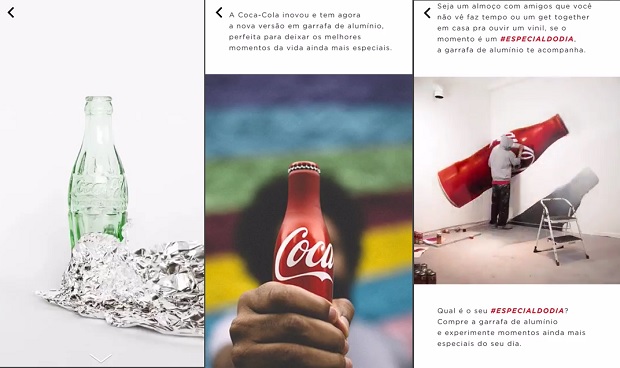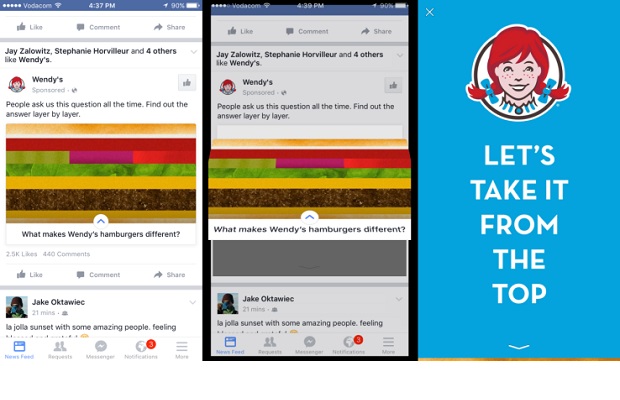Facebook ads can now takeover you phone, with a new ‘Canvas’ size that imitates Snapchat’s ‘Discover’ format. But will it turn off consumers?
Canvas, which went live today, lets advertisers create a full-screen ad on the mobile News Feed-providing more impact on phones and tablets.
The ad appears as a traditional post on Facebook, but once users click, their screens will be taken over with a full-screen display ad.
The ads are in interactive, so can feature still images, text, videos and call-to-action buttons.
In a statement, Facebook outlined the key features of Canvas (republished below):
⦁ Native: Canvas was built within Facebook and so it loads as much as 10 times faster than the standard mobile web.
⦁ Fully customisable space: Advertisers can build ads using a mix of video, images, text and call-to-action buttons.
⦁ Available internationally: Any advertiser can start building a Canvas today.
⦁ Space for everyone: Easy to build with no code or software required. Works on both Android and iOS.
The style recalls Snapchat’s ‘Discover’ ads, which offers brands a full mobile page immersive experience- suggesting Facebook is taking cues from its smaller rival.
“We’ve only built the shelf. What’s more exciting to me is what is going to happen when this gets into the hands of the creators,” Jessica Watson, the product design manager, said at the global launch event of Canvas in Facebook’s New York headquarters.
Many big name advertisers are already on board, including Coca-Cola, Wendy’s, Universal Pictures, BMW and Burberry.
See the Coca-Cola example below:
Coca Cola built a Canvas that featured the newly launched special series of Aluminum Bottle. They reached nearly 16 million people and had an average view time of 18 seconds.

Doubling down on mobile growth
Facebook will sell Canvas ads in two ways, to appeal to brand advertisers and online advertisers. For brands used to TV commercial slots, Facebook will sell the form on a cost-per-thousand basis.
It will also sell the screen takeovers on a cost-per-click basis, a metric used by online advertisers looking to generate click-throughs or conversions.
The new units are certain to boost Facebook’s mobile ads, which now account for 80% of the social network’s revenue.
“We made the creative community a priority when we designed and built Canvas. It’s a product that represents our commitment to creative craft and delivering the best mobile experience for businesses and people.” – Chris Jones, Head of Creative Technology, Facebook Creative Shop.
Analysis: Going big in an era of ad avoidance
The move marks a major shift in Facebook’s mobile advertising strategy, and a bold bet on premium inventory. Brands are looking for high impact spaces and until now, Facebook hasn’t had a product that satisfies that need.
If Facebook is putting its advertisers first, it makes sense. However, if the social network wants to put consumers first it may be a different story. As ad blocking rises in popularity, the interuptive nature of these units could turn off some users.
The acceptance of the new page takeovers may depend on the region. Every country has different expectations of advertising editorial ratios, so while US consumers may be comfortable (in a culture where 20 minutes of every hour of TV is commercials), other markets like the UK and Germany may be different (on UK television the commercial airtime each hour is closer to 6 minutes).
However, the new format could also offer an improved ad experience: Canvas opens a full-screen, rich media page inside of Facebook rather than forcing users to wait for a mobile website to load- much in the same way that Instant Articles works for publishers on Facebook.
“Ad-blocker arms race will continue”
Commenting on the new format, Danny Meadows-Klue, President of the Digital Training Academy, said: “For Facebook, the small screen is the biggest challenge. Since Zukerberg’s reorientation of the platform to mobile first experiences, advertisers have moved into the newsfeed. That’s worked well for the brands, and because of the relevancy of the targeting (all that data from where you are, what you click, like and share everyday ensures this), people have been broadly accepting. The difference with the full screen experience is simply the scale of interruption.”
How will Canvas roll out? Meadows-Klue has 4 predictions:
· “Facebook is likely to bring this in slowly, capping frequency to no more than a couple per week per person in most markets
· They’ll work with brands to create brilliant creative that entertains as well as delivers the message (look for movies and TV shows to be among the first)
· For the first 6 months they’ll target very precisely, using traditional demographics as well as the claimed and observed behavior data the platform is famous for
· And the AdBlocker arms-race will continue, with Facebook following the IAB’s “DEAL” approach for protecting its inventory”
Canvas is a mobile-only experience and works on both Android and iOS. Advertisers with access to Power Editor can start creating Canvases now.
For more information on how to create a Canvas video, click here.


Digital Advertising Trends Emerge: Mobile Users are Valuable
[…] now, it appears vertical video is just the beginning. Canvas, a new ad functionality from Facebook, enables advertisers to create immersive full-screen mobile ads inside the social media network […]